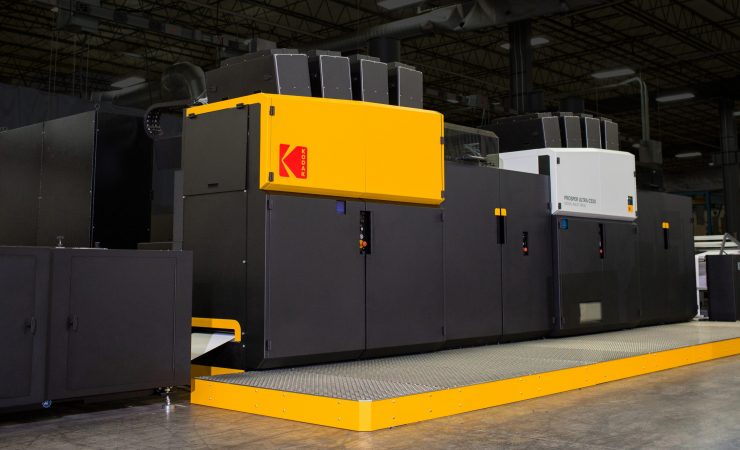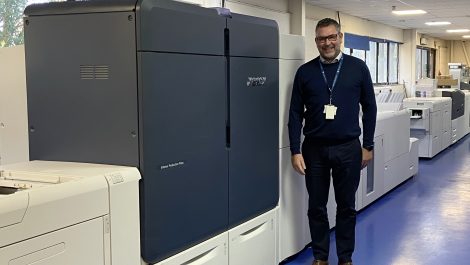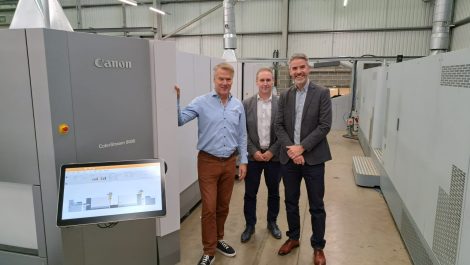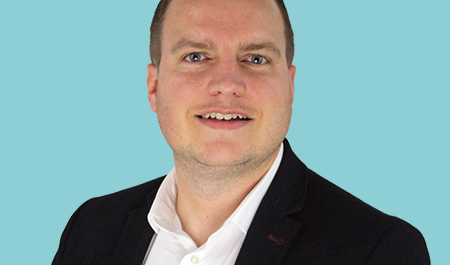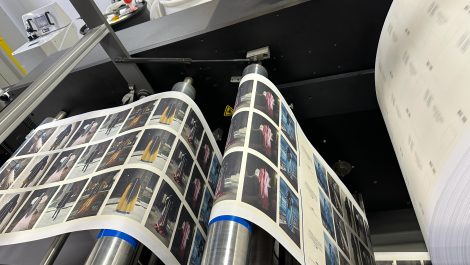In a raft of announcements that would have been made at drupa today, Kodak introduced its first inkjet press for commercial applications, the Prosper Ultra 520, Prinergy on Demand, a scalable subscription-based update to its open workflow software, a wider version of the Uteco Sapphire Evo press for flexible packaging, plus improvements to its Sonora plate line and Magnus platesetters.
Executive chairman Jim Continenza spoke of the ‘new Kodak‘ that was now in a better financial position than for 20 years, ‘easier to do business with’ and fully focused on print, films and chemicals. He said that the company is ‘doubling down on digital because the future is digital print’.
Prosper Ultra 520 inkjet press
Aimed at mid-volume production, the Prosper Ultra 520 is a 150m/min 520mm width roll-fed inkjet that brings Kodak’s Ultrastream continuous flow inkjet technology to the commercial print market. Senior VP of Kodak’s Digital Print business Randy Vandagriff extolled the benefits of Ultrastream, whose uniformly sized and shaped 3.75pl drops of water based-ink allow for accurate placement in a wide range of applications, and said that the new press was ‘closing the offset quality gap’ with quality that was ‘virtually indistinguishable from offset’.
The Ultra 520 will be offered in commercial and publishing variants, with the main difference being the drying system, with the former requiring more capacity to reflect high coverage levels. Both will print CMYK at 600x1800dpi, equivalent to a 200line screen in offset printing, and can handle stock from 45 to 270gsm, including glossy papers with high coverage – an inline priming system is used where necessary, or pre-primed stock can be used. Throughput is 2000 duplex A4 pages a minute, and monthly duty cycle is around the 10 million mark. Mr Vandagriff claimed the press has the lowest running costs in its class, especially with heavy coverage at high volume, and that its water-based inks were immune to rising solvent costs. It is driven by a Kodak DFE that’s based on Adobe’s APPE 5 RIP technology.
The Prosper Ultra 520 is expected to cost around US $2 million, around half the price of the existing Prosper 6000, which continues for higher volume (20 million impression per month) and less quality intensive requirements. Applications for the Ultra 520 include general commercial print, direct mail, periodical publishing, books and manuals. Beta testing will being later this year and commercial availability is expected in 2021. A single-sided application for carton print is a possibility, as this can be done in the Prosper 6000. Discussion with partners re a possible corrugated version are in progress and when asked if there would be a cut-sheet version, Mr Continenza said, ‘we’re working on it’.
Prinergy on Demand
Having moved components of its long established Prinergy workflow online in the last couple of years, Kodak is now going fully Cloud-based with a scalable, monthly subscription based version, Prinergy on Demand, that supports a wide range of other hardware and software vendors’ offerings as well as Kodak’s. VP of the Digital Print business Todd Bigger emphasised the security aspect, with the software hosted on Microsoft Azure servers; the ‘always on’ nature of the software regardless of local events; reduced cost of ownership through proactive monitoring and maintenance; and data analytics capabilities that will help find bottlenecks and errors in production flows. AI capabilities are to be added to this in the near future.
Mr Bigger said that the printing structure is based on the server and managed services, with all licenses included in the monthly subscription cost, which can be varied to meet production requirements, saying the entry point is ‘now much easier, it’s operational expenditure, not capital expenditure’. The Cloud-based service is available immediately, with multi-tenant (shared) options to be added later this year.
Nexfinity relaunched
Kodak is also relaunching its flagship cut-sheet toner press, the Nexfinity, which was introduced in early 2018. The press, which builds on the success of the Nexpress line, now offers 152ppm top speed (though this is when print in 1300mm long sheet mode for six-page A4 products or similar), putting it at the top end of cut-sheet toner productivity. Jeff Zellmer, VP for global sales and strategy, also emphasised the solid build quality, based like its predecessors on a Heidelberg chassis – ‘it’s built like a press, not like a laser printer’ – and its lead edge perfecting and ‘spot on’ registration compared to alternatives.
Another attribute of the Nexfinity he mentioned is the flexibility offered by the fifth colour station, which can be changed over in minutes. Mr Zellmer admitted to Digital Printer that Kodak had not sold ‘as many as we would have liked’ of the Nexfinity since its introduction two years ago; the only UK installation of which we are aware is at Matthews the Printers in London. He spoke also of various internal improvements that had been made to increase the life of consumable parts and how the Nexfinity’s profitability increases with throughput: ‘between half a million and a million impression a month, the more you do, the more profitable it is,’ he said.
Packaging and offset
Kodak is also introducing with Uteco a 1.25m width version of the Uteco Sapphire Evo press for flexible packaging. Also based on Ultrastream technology with water-based inks, the new Evo model is expected to compete with flexo and gravure print; running at between 25 and 50m/min, Mr Continenza said ‘there’s nothing digital at that width’.
Enhancements to the Sonora range of processes offset plates and the Magnus line of platesetters were also announced.
